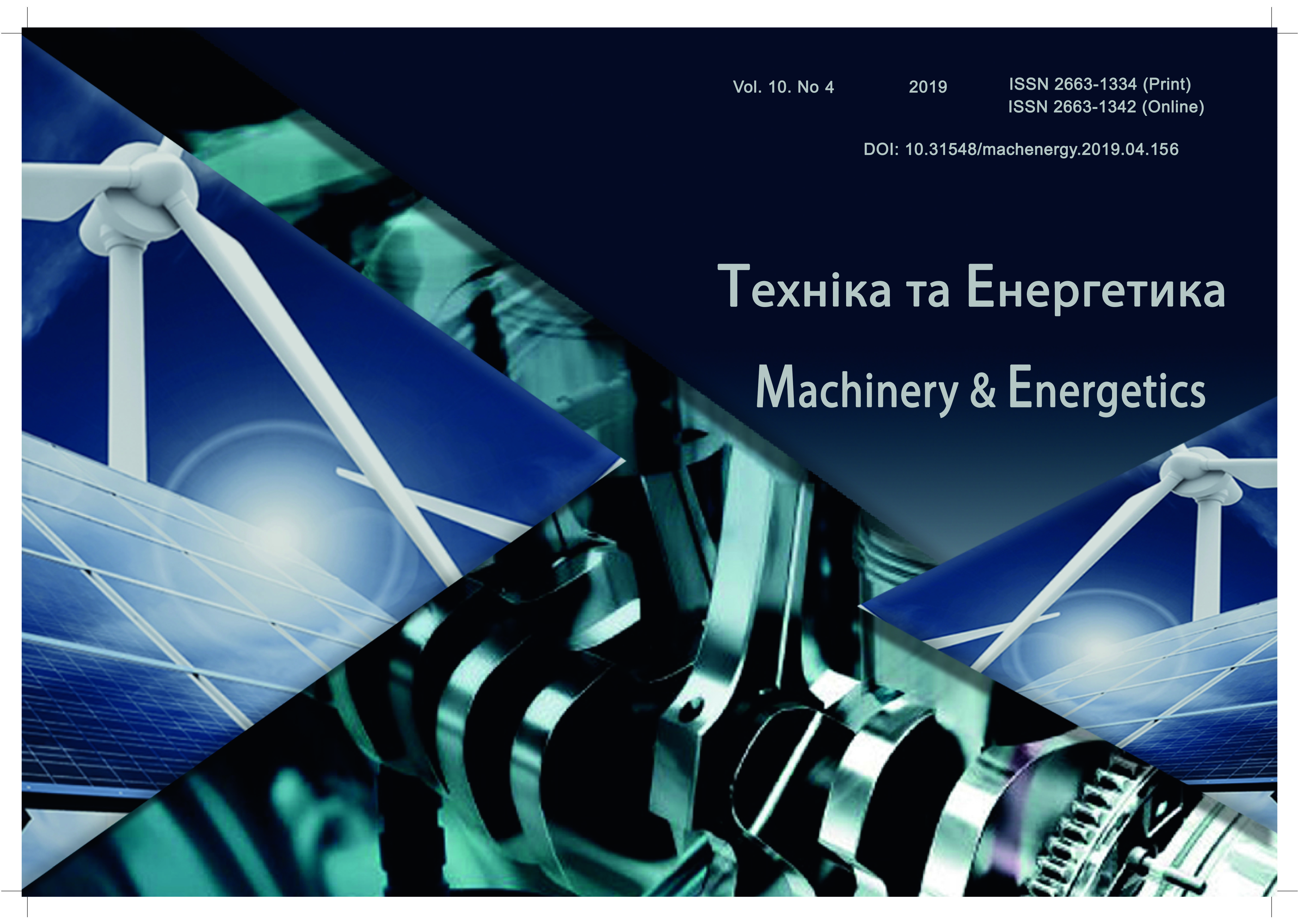Методика експериментальних досліджень гідропосіву пророзшого насіння
DOI:
https://doi.org/10.31548/machenergy2019.04.129Ключові слова:
експеримент, план експерименту, установка, рандомізація факторів, емпіричні коефіцієнти.Анотація
Обґрунтований метод та дискретно – континуальна модель для аналізу вимушених коливань пружних елементів (канатів) вантажопідйомних механізмів кранів при довільному й гармонічному від часу законів зміни зовнішніх сил. Запропонований критерій якості руху канатів вантажопідйомного механізму крана, який при його реалізації дозволяє встановлювати такі режими руху пружних елементів, котрі мінімізують напруження у останніх. Реалізація цілі даного дослідження дозволяє встановити коефіцієнти динамічності у різних перерізах канатів та вказати методи / напрямки, які ведуть до їх мінімізації на перехідних ділянках функціонування вказаних механізмів підйому вантажу кранів.
Розв’язок відповідних диференціальних рівнянь, які є математичною моделлю задачі, здійснений шляхом розкладу у ряд за власними функціями шуканих розв’язків вказаних рівнянь (у частинних похідних по просторовій й часовій координатам). Для зовнішнього навантаження обраний узагальнений закон зміни у просторі й часі. Знайдені умови резонансу / антирезонансу у випадку гармонічної збуджуючої зовнішньої сили для різних кінцевих (граничних умов закріплення пружного елементу (канату).
Посилання
Nedovyesov, V. I., Loveikin, V. S., Bondar, N. A., Shimko, L. S. (2009). Patent 87400 Ukraine, IPC A01D 41/00. Combine harvester, the applicant and owner of the national scientific center "Institute of mechanization and electrification of agriculture" UAAS. № a 2008 00 537, Appl. 15.01.2008, publ. 25.04.2008, bull. No. 8.
Nedovyesov, V. I., Loveikin, V. S., Bondar, N. A., Shimko, L. S. (2009). 44046 Patent, Ukraine, IPC A01F 12/60. The hopper combine harvester, the applicant and owner of NULESU. - № u 2009 05 304, Appl. 27.05.2009, publ. 10.09.2009, bull. No. 17.
Nedovyesov, V. I., Loveikin, V. S., Bondar, N. A., Shimko, L. S. (2009). 49301 Patent, Ukraine, IPC 01D 41/00. Combine harvester, the applicant and the owner of NULESU. № u 2009 11 175, Appl. 04.11.2009, publ. 26.04.2010, bull. No. 8.
Nedovyesov, V. I., Loveikin, V. S., Bondar, N. A., Shimko, L. S. (2009). 51244 Patent, Ukraine, IPC A01F 12/60. The hopper combine harvester, the applicant and owner of NULESU. - № u 2009 13874, Appl. 29.12.2009, publ. 12.07.2010, bull. No. 13.
Takahasi, K. (1937). The Gravity flow in nature. Geophys. Mag. Vol. 11. 165-175.
Roberts, A. (1969). Study the expiry is a bulk granular material through the discharge chute under its own weight. Proceedings of the American society of mechanical engineers. Design and manufacturing engineering. Vol. 9, Series V. No. 2. 87-96.
Roberts, A. W. (1960). Trans. ASME, J. Engng. Ind., 91. 373-381.
Ishida, M., Shirai, T. (1979). Velocity Distributions in the Flow of Particles in an Inclined Open Channel. J. Chem. Eng. Jpn. Vol. 12. 45-50.
https://doi.org/10.1252/jcej.12.46
Savage, S. B., Sayed, M. (1980). Experiments on dry cohesion less materials in annular cell at high stain rates.-Presented at EUROMECH 133-Statics and Dynamics of Granular Materials, Oxford University.
Savage, S. B. (1987). Interparticle percolation and segregation in granular materials: A review. In A. P. S. Selvaduraj (ed) Development in Engineering Mechanisms, Elsevier Science Publishers B. V., Amsterdam. 347-363.
Dolgunin, V. N. (2005). Rapid gravity flow of granular materials: technique of measurement, the patterns used in technological applications. Moscow. Mechanical engineering. 112.
Borschev, V. J. (2002). Computer processing of radiographs in the study of the dynamics of rapid gravity flows of granular media. Mathematical methods in technics and technology: collected papers. Tambov, Vol. 7. 34-37.
Kulikovsky, V. L., Paliychuk, V. K., Borovsky, V. M. (2017). Injury of the grain material of screw working bodies of screw feeders. Design, production and operation of agricultural machinery. Kropiwnicki. CSTS. Vol. 47, C. I. 124-131.
Derevyanko, D. A. (2014). Injury and seed quality at different stages of technological processes. Engineering nature. No. 1(1). 114-123.
Kirpa, N. J. (2013). Injury of seeds: causes and consequences. Storage and processing of grain. Vol. 2 (167). 29-31.
Loveikin, V. S., Shimko, L. S. (2011). Experimental study of the process of discharging grain materials from a dump hopper of the combine. Scientific reports Nulesu. Kiev. Vol. 6(28): http://nd.nubip.edu.ua/2011_6/titul.html.
Loveikin, V. S., Shimko, L. S. (2015). Optimization of operation modes of dump eventaually devices. Kiev. 292.
Завантаження
Опубліковано
Номер
Розділ
Ліцензія
Стосунки між правовласниками і користувачами регулюються на умовах ліцензії Creative Commons Із Зазначенням Авторства – Некомерційна – Поширення На Тих Самих Умовах 4.0 Міжнародна (CC BY-NC-SA 4.0):https://creativecommons.org/licenses/by-nc-sa/4.0/deed.uk
Автори, які публікуються у цьому журналі, погоджуються з наступними умовами:
- Автори залишають за собою право на авторство своєї роботи та передають журналу право першої публікації цієї роботи на умовах ліцензії Creative Commons Attribution License, котра дозволяє іншим особам вільно розповсюджувати опубліковану роботу з обов'язковим посиланням на авторів оригінальної роботи та першу публікацію роботи у цьому журналі.
- Автори мають право укладати самостійні додаткові угоди щодо неексклюзивного розповсюдження роботи у тому вигляді, в якому вона була опублікована цим журналом (наприклад, розміщувати роботу в електронному сховищі установи або публікувати у складі монографії), за умови збереження посилання на першу публікацію роботи у цьому журналі.
- Політика журналу дозволяє і заохочує розміщення авторами в мережі Інтернет (наприклад, у сховищах установ або на особистих веб-сайтах) рукопису роботи, як до подання цього рукопису до редакції, так і під час його редакційного опрацювання, оскільки це сприяє виникненню продуктивної наукової дискусії та позитивно позначається на оперативності та динаміці цитування опублікованої роботи (див.The Effect of Open Access).

